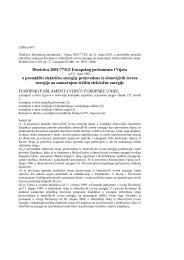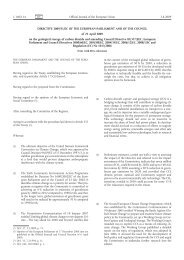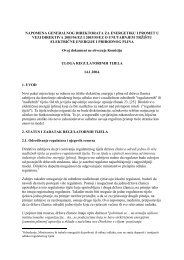You also want an ePaper? Increase the reach of your titles
YUMPU automatically turns print PDFs into web optimized ePapers that Google loves.
Scenarij N-1<br />
Scenarij N-2<br />
Scenarij N-3<br />
Scenarij ograniËene izgradnje, u<br />
kojem se do kraja planskog razdoblja<br />
(2025.) predviapplea ulazak u<br />
pogon drugog bloka TE Pljevlja,<br />
te odreappleenog broja malih elektrana<br />
koje koriste obnovljive izvore energije<br />
(male HE, vjetroelektrane, TE<br />
na otpad),<br />
Scenarij umjerene izgradnje, u<br />
kojem se do 2025. godine, pored<br />
izgradnje objekata iz scenarija N-1,<br />
predviapplea i izgradnja HE na MoraËi,<br />
te HE Komarnica,<br />
Scenarij intenzivne izgradnje, u<br />
kojem se osim elektrana iz scenarija<br />
N-2, grade i HE Koπtanica<br />
(uz prevoappleenje dijela voda Tare u<br />
MoraËu), HE Ljutica i HES Buk<br />
Bijela.<br />
Definiranjem ulazaka elektrana u pogon prema tim<br />
scenarijima, tamo gdje je izgradnja intenzivnija<br />
moæe se oËekivati pojava odreappleenog viπka elektriËne<br />
energije u bilanci. Zbog dobre povezanosti<br />
crnogorskog EES-a s okolnim sustavima, kao<br />
i zbog procesa stvaranja regionalnog træiπta<br />
elektriËne energije u jugoistoËnoj Europi, u tim<br />
je scenarijima pretpostavljeno da Êe se ti viπkovi<br />
plasirati na okolnom træiπtu. Radi ravnopravnosti<br />
tretmana, cijene po kojima se izvozi elektriËna<br />
energija pretpostavljene su na jednakim razinama<br />
kao i cijene uvoza elektriËne energije,<br />
odnosno vezane su uz cijene terminskih ugovora<br />
(futures) na burzi EEX. Kad je rijeË o konkretnim<br />
elektranama, viπak proizvodnje termoelektrana<br />
pretpostavljen je kao izvoz bazne energije, dok je<br />
za hidroelektrane viπak proizvodnje pretpostavljen<br />
kao izvoz vrπne energije.<br />
Dakako da je vrlo teπko toËno predvidjeti kretanje<br />
cijena na træiπtu elektriËne energije za razdoblje od<br />
20 godina u buduÊnosti. U posljednjim godinama<br />
doæivjeli smo priliËno dramatiËne promjene u<br />
energetici na globalnom planu i posljediËno<br />
porast cijena svih oblika energije. Daljnji porast ili<br />
eventualna stabilizacija cijena ovisit Êe o brojnim<br />
politiËkim i geostrateπkim Ëimbenicima koje nije<br />
jednostavno predvidjeti na dugi rok.<br />
U nastavku su pokazani osnovni rezultati prora-<br />
Ëuna za naprijed spomenute scenarije, dinamika<br />
ulazaka u pogon novih elektrana te struktura izvora<br />
u pokrivanju potroπnje.<br />
Scenario N-1<br />
Scenario N-2<br />
Scenario N-3<br />
This is a scenario of limited construction,<br />
in which the entry into operations<br />
of the second block of the Pljevlja<br />
Thermoelectric Power Plant and a certain<br />
number of small power plants that<br />
use renewable energy sources (small<br />
hydroelectric power plants, wind power<br />
plants, waste-fueled thermoelectric<br />
power plants) is anticipated by the end<br />
of the planning period (2025).<br />
This scenario is oriented to moderate construction,<br />
in which in addition to the construction<br />
of the facilities from Scenario<br />
N-1, the construction of a hydroelectric<br />
power plant on the MoraËa River and the<br />
Komarnica Hydroelectric Power Plant is<br />
anticipated by the year 2025.<br />
This is a scenario of intensive construction,<br />
in which in addition to the power<br />
plants from Scenario N-2, there would<br />
also be construction of the Koπtanica<br />
Hydroelectric Power Plant (with the rerouting<br />
of part of the water from the Tara<br />
River into the MoraËa River), the Ljutica<br />
Hydroelectric Power Plant and the Buk<br />
Bijela Hydroenergy System (HES).<br />
According to the definition of the placing of power<br />
plants into operation as provided by these scenarios,<br />
a certain energy surplus in the balance may be<br />
expected where construction is more intensive. Due<br />
to the good connections of the Montenegro Electrical<br />
Energy System with the surrounding systems, as well<br />
as the process of creating a regional electrical energy<br />
market in Southeastern Europe, with such scenarios<br />
it is assumed that the surpluses would be sold on<br />
the surrounding markets. For the purpose of equal<br />
treatment, the prices at which electrical energy would<br />
be exported are assumed to be at the same levels as<br />
the prices of imported electrical energy, i.e. linked to<br />
the prices of futures contracts on the European Energy<br />
Exchange (EEX). When speaking about specific power<br />
plants, surplus production of thermoelectric power<br />
plants is assumed to be the export of base energy, while<br />
for hydroelectric power plants the surplus production is<br />
assumed to be the export of peak energy.<br />
It is certainly very difficult to anticipate the price trends<br />
on the electrical energy market for a period of 20 years<br />
into the future. In past years, we have experienced<br />
fairly dramatic changes in energetics on the global level<br />
and the consequent increase in the cost of all forms<br />
of energy. Continued growth or eventual stabilization<br />
of prices will depend on numerous political and<br />
geostrategic factors that are not simple to forecast over<br />
a long period.<br />
In the next sections, the basic results of estimates for<br />
the aforementioned scenarios, the dynamics of the<br />
319<br />
Zeljko,<br />
M., »anoviÊ, M., Energetski sektor Crne Gore..., Energija, god. 56(2007), br. 3., str. 292∑327<br />
Zeljko, M., »anoviÊ, M., The Current Situation and Future..., Energija, vol. 56(2007), No. 3, pp. 292∑327

















